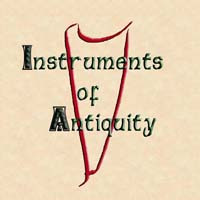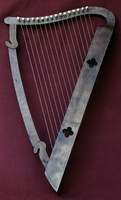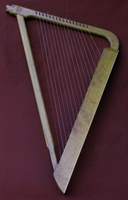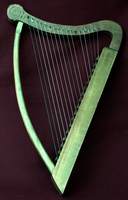
create for you?
(Links lead to detailed pages with larger photos and more information...)
Authentic:
Citole:
Cantigas style
Warwick style
Drums:
Bodhran
Gusli
Harps:
Bardic/Lap Harps:
Gut Strung
Celtic Wire Strung
Floor Harps:
Gothic
(more to come)
Kantele:
5 string
5 string Piccolo
9 string
Performance set
Lyres:
Trossingen
Sutton Hoo
Mosning Thorpe
Bergh Apton
Oberflacht
Cologne
Student Model
Bowed Lyres:
Crwth
Jouhikko
Psaltries:
Pig Nose
Cantigas style
Rebecs:
Soprano
Alto
Tenor
Bass
Zithers:
Fretted:
Epignette
Scheitholt
Fretless:
Myrna Hammered Dulcimer
Echoic:
Non-authentic,
but imitative of
the sound of the original instrument
Flutes
Whistles
Bardic/Lap
Harps
Click
Thumbnail Images to Enlarge
 The harp is a
multi-stringed instrument in which the strings emerge perpendicular to
the soundboard with no acoustic bridge to couple the vibrations to the
instrument. The earliest harps were little more than specialized
hunter's bows with a sound cavity on one end and a few strings instead
of one. These angle harps were common for thousands of years, but
were more limited due to the mechanics involved in supporting a number
of fully tensioned strings in an open structure.
The harp is a
multi-stringed instrument in which the strings emerge perpendicular to
the soundboard with no acoustic bridge to couple the vibrations to the
instrument. The earliest harps were little more than specialized
hunter's bows with a sound cavity on one end and a few strings instead
of one. These angle harps were common for thousands of years, but
were more limited due to the mechanics involved in supporting a number
of fully tensioned strings in an open structure.In the moddle of the 8th century, we begin to see in Irish stonecarvings a further development of the angle harp, the addition of a pillar that allowed more and higher tensioned strings. This instrument was the ancestor of all modern triangular 'frame' harps.
In the 9th century in France we start to get manuscript illustrations of smaller triangular frame harps, and by the 10th century references occur in all historical media from woodcarving to manuscripts to paintings and even textiles. The earliest triangular frame harps had straight arms, which made for an unbalanced playing instrument with the string technologies of the day. Soon the harmonic curve replaced the straight arm, allowing the center strings to be shorter and therefore lower tension than previously possible. This allowed more strings to be placed ont eh frame without stressing the arm to failure, and had the added benefit of balancing tone and volume across the string band.
The lightest of the bardic harps was the welsh Telyn Rawn (harp of the horse-hair). It was the most respected musical instrument of the Irish and Welsh bards through the 15th century. It had a light sound, was usually fitted with brays to give volume and impact, and was so important that it's value was used to set such things as bride-price.
The gut-strung harp was more heavily built, louder, and clearer but not as popular or well accepted as the horse-hair variety. as a small harp, there was something culturally and traditionally about the sound of the heavier harp that didn't gain a strong hold until the 16th century.
It was not until the later part of the medieval period that wore strung Clarscah became popular, but these were much heavier built and required a completely different playing style, and as such are not included here in the category of bardic harps (although they most certainly served that function)
 Our
bardic harps are built in the styles of the early Welsh, Irish and
Romanesque small harps popular in the early era of triangular frame
harp. They are available with gut, nylon, or horsehair strings,
and with or without bray pins. They are available with wooden or
steel tuning pins. A variety of wood species can be used in these
instruments, along with a variety of finishes. It is important to
remember that the bardic small harps are not the folk Celtic harps of
today, they are intimate instruments, portable with a strong organic
sound, but they are not a replacement for a modern small lever
harp. These are the harps that put heroic deeds to music and into
the history books.
Our
bardic harps are built in the styles of the early Welsh, Irish and
Romanesque small harps popular in the early era of triangular frame
harp. They are available with gut, nylon, or horsehair strings,
and with or without bray pins. They are available with wooden or
steel tuning pins. A variety of wood species can be used in these
instruments, along with a variety of finishes. It is important to
remember that the bardic small harps are not the folk Celtic harps of
today, they are intimate instruments, portable with a strong organic
sound, but they are not a replacement for a modern small lever
harp. These are the harps that put heroic deeds to music and into
the history books.For those who have the wanderlust, those who view the actions of men in shades of vivid musical color and who see history as a powerful and unstoppable heroic epic, we can help you find your place among the warrior bards of old. Please contact us and let us show you how your one-of-a-kind harp can sing of the brave and free, and carry on today the grandest tradition, that your harp, and you, shall never sing in slavery.

For
more information or to place an order, contact:
Chris Nogy,
founder and craftsmancontact@instrumentsofantiquity.com
Phone: 479-283-6364
Please call between 9 AM and 7 PM U.S. Central Time (-6 GMT)
copyright (c) 2011